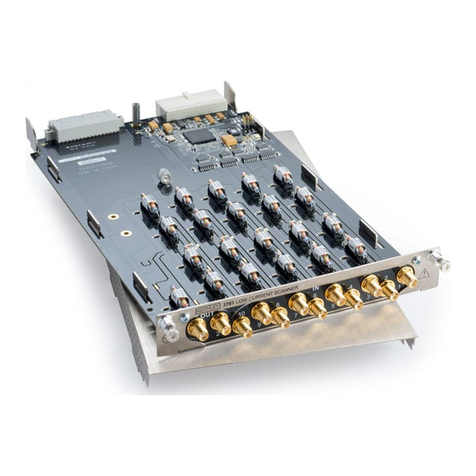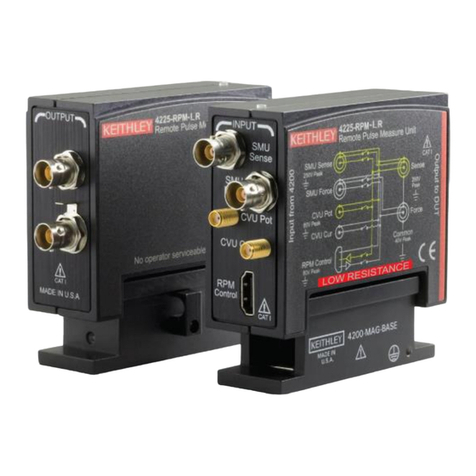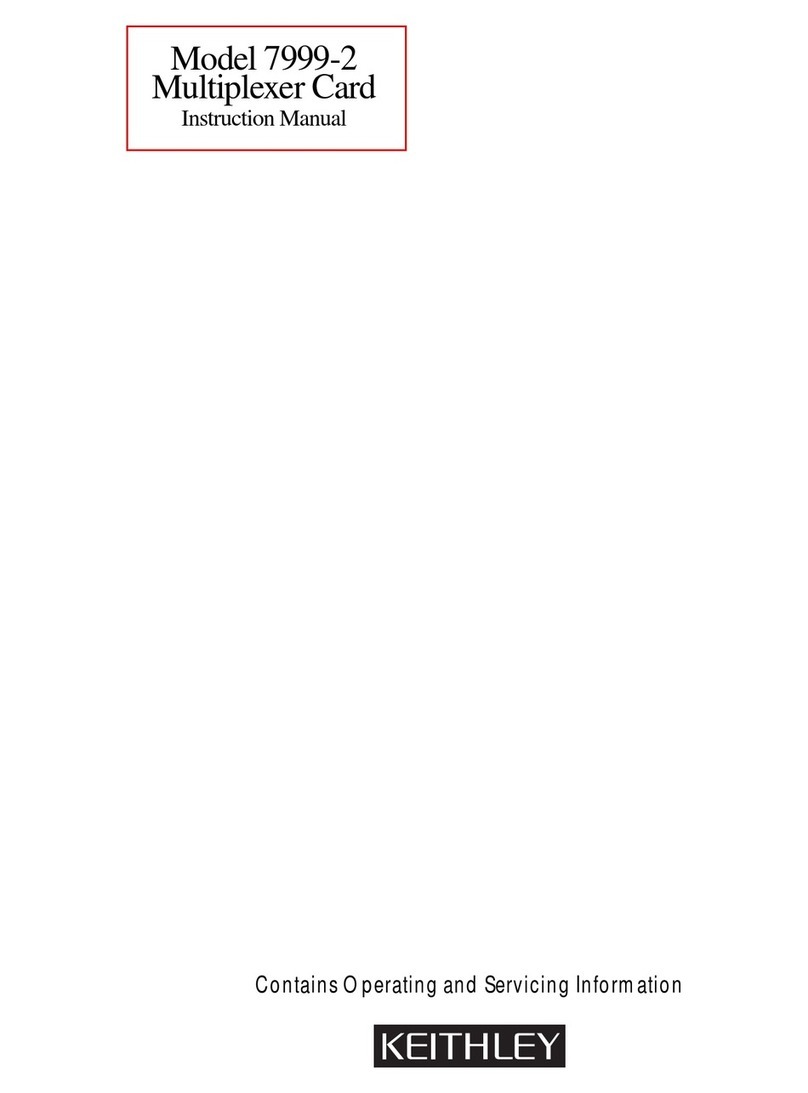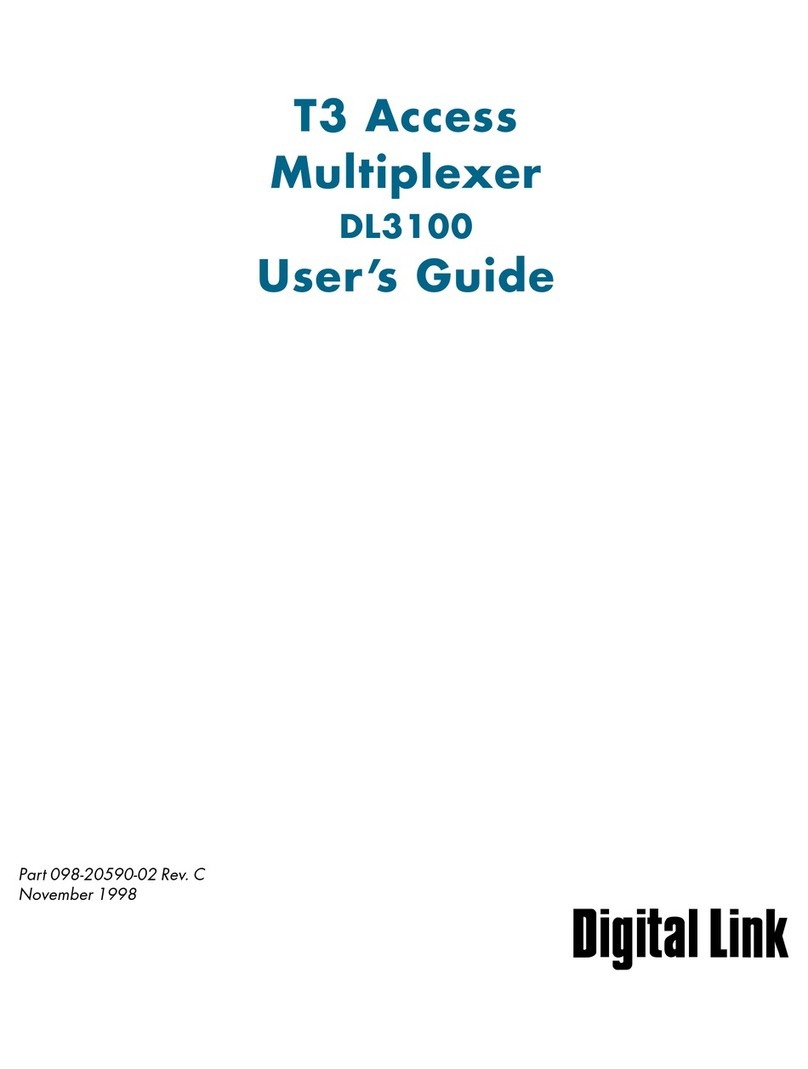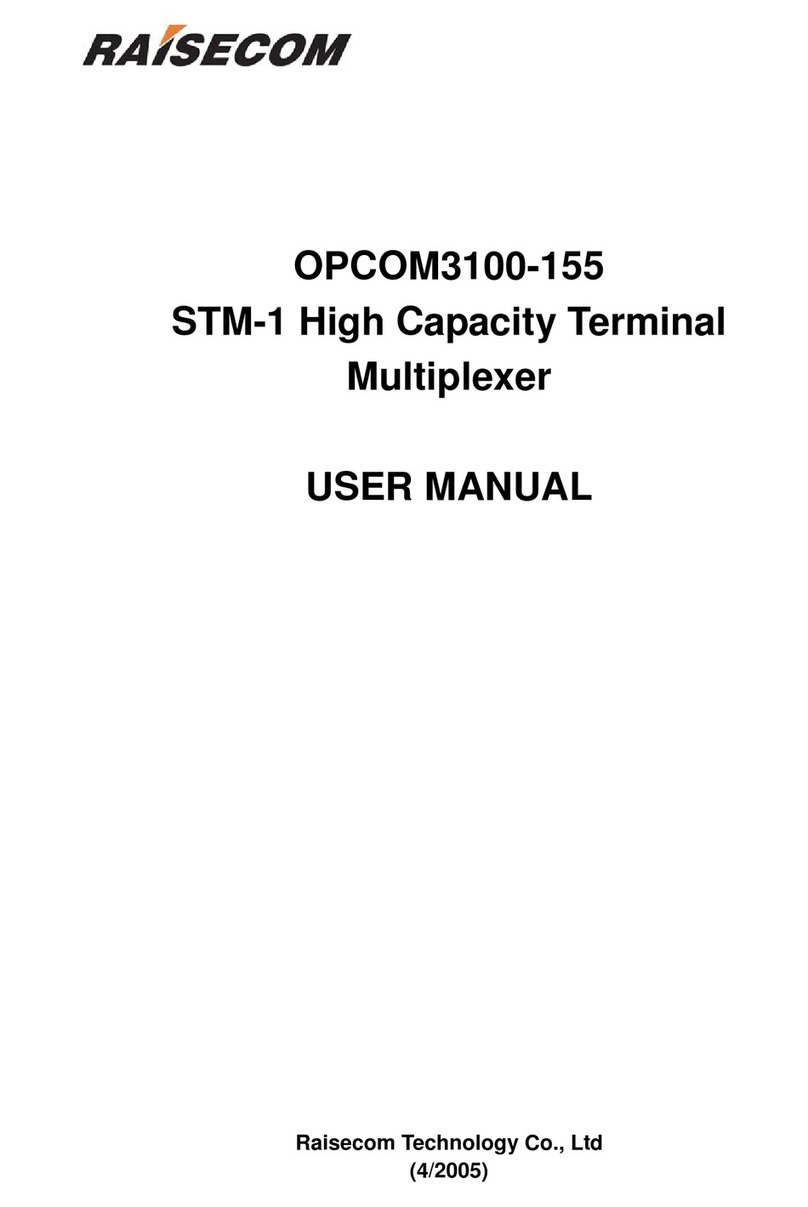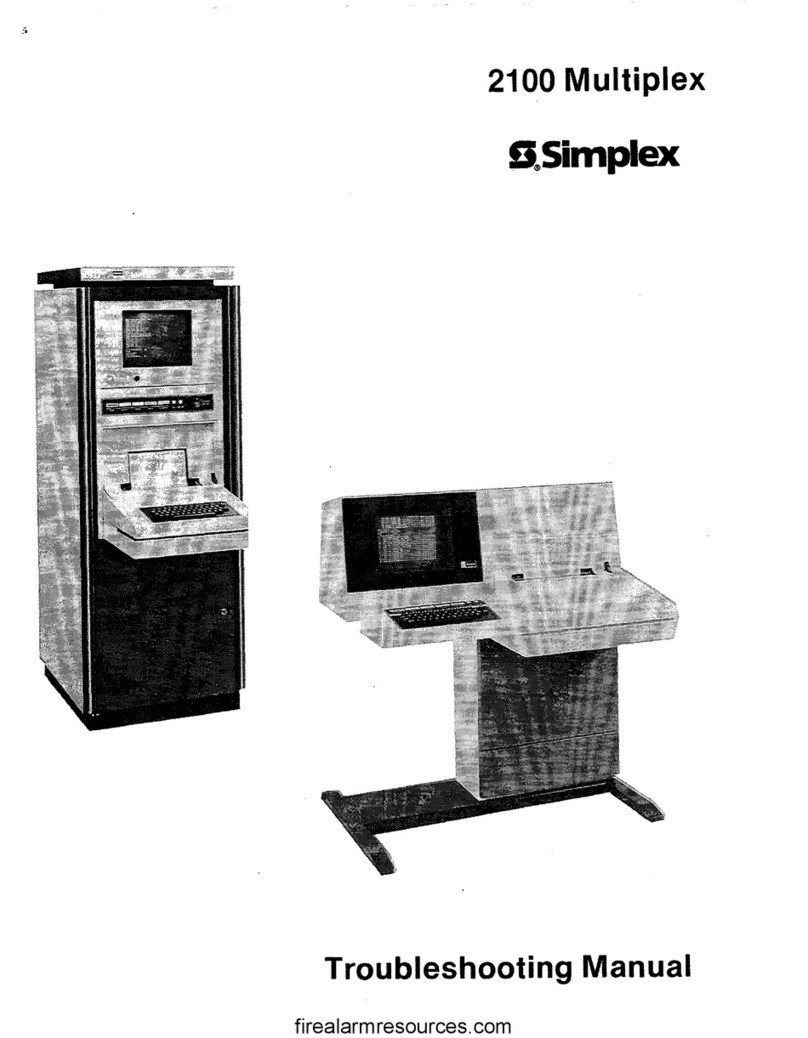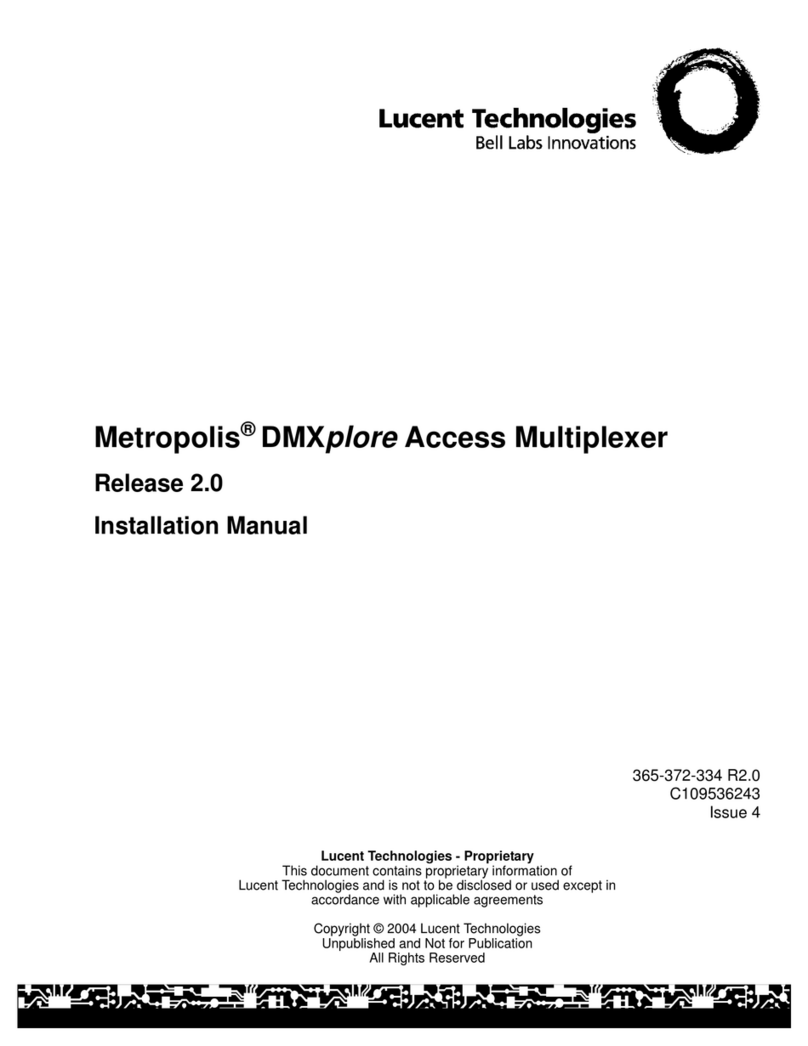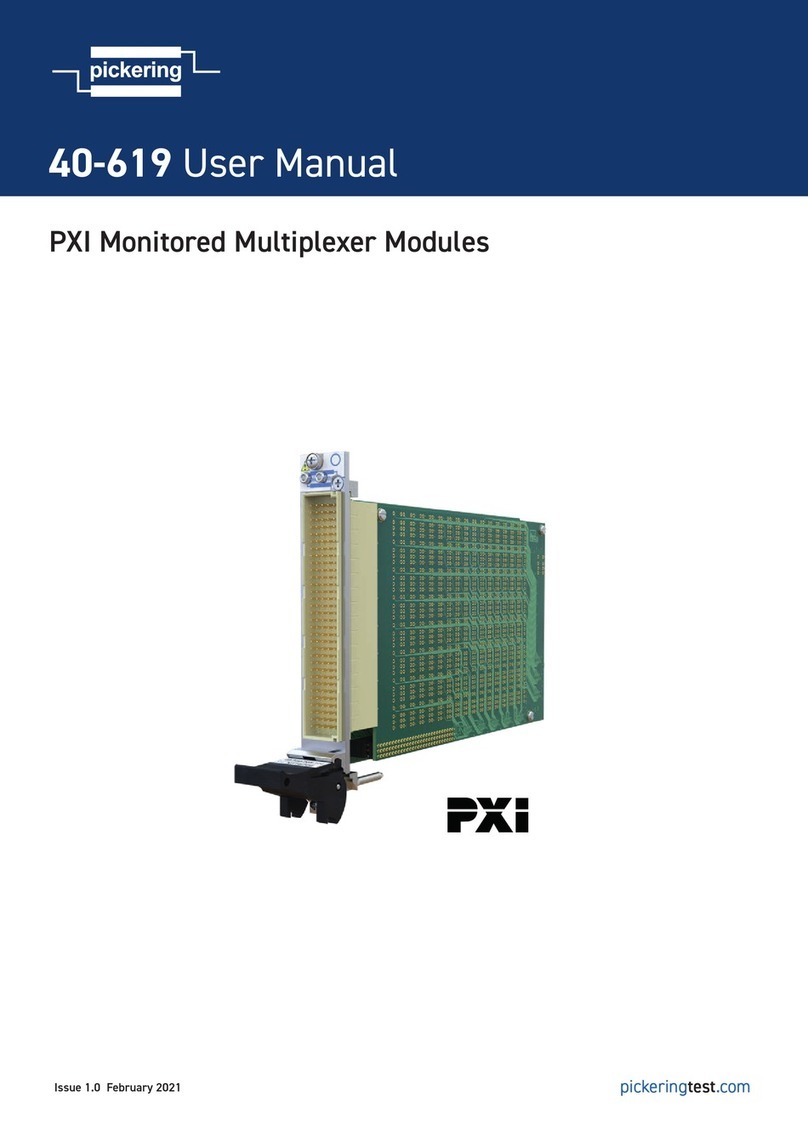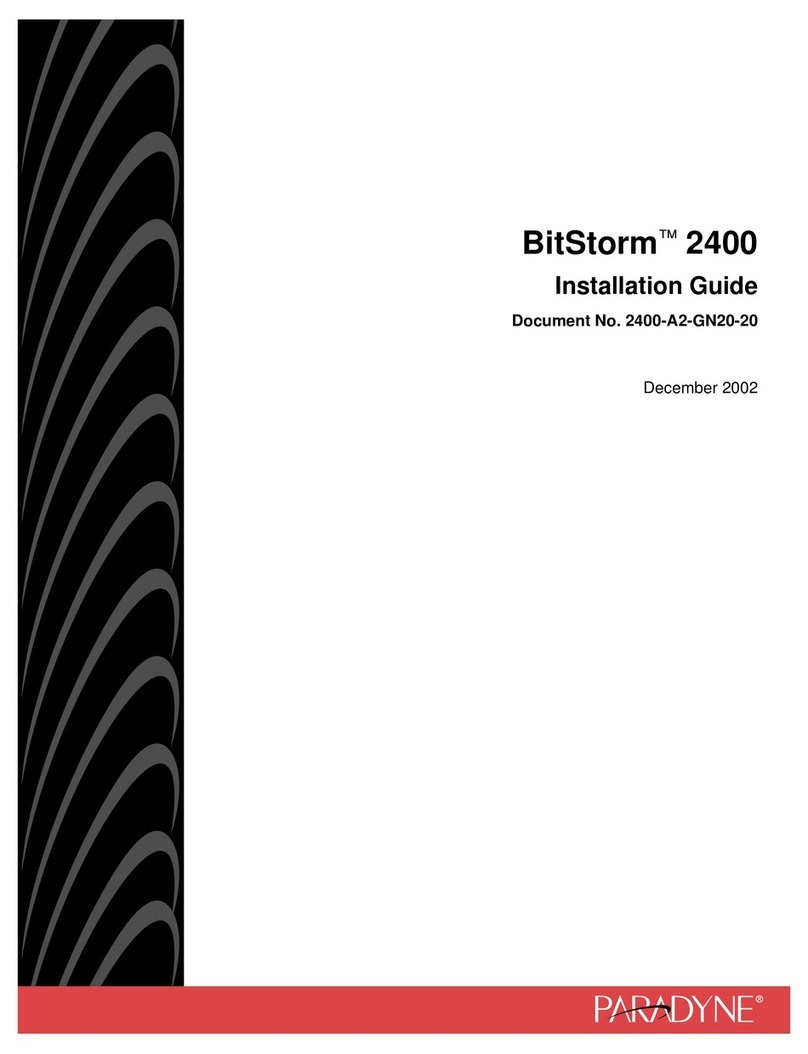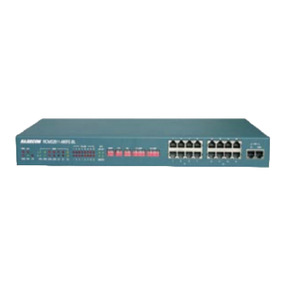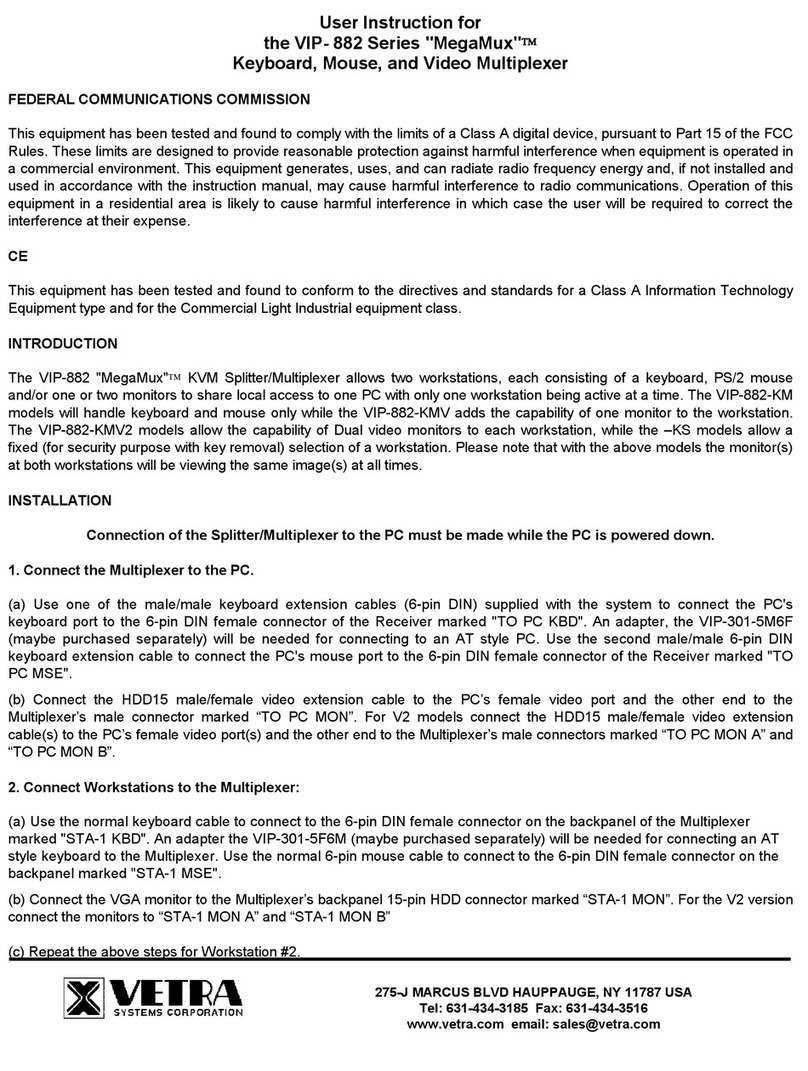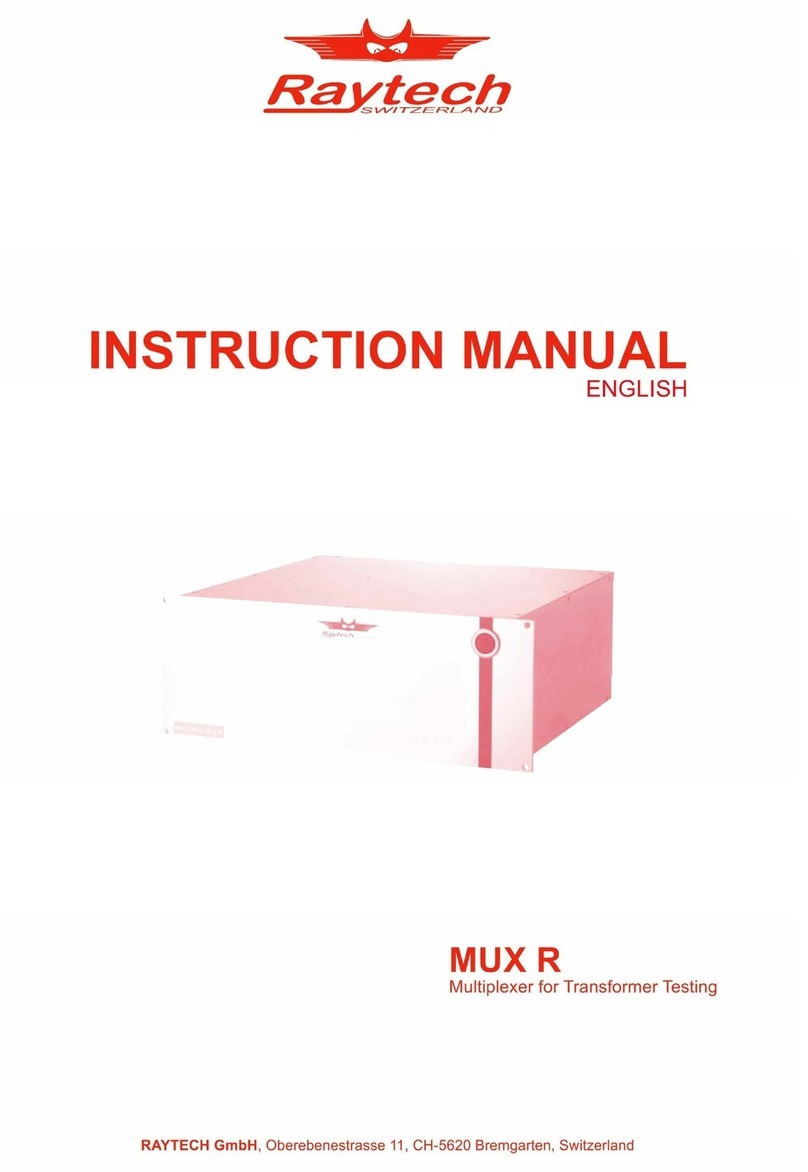Keithley 7016A User manual

Instruction Manual
Model 7016A
50
Ω
2GHz Multiplexer Card
Contains Operating and Servicing Information
7016A-901-01 Rev. A / 5-99

WARRANTY
Keithley Instruments, Inc. warrants this product to be free from defects in material and workmanship for a period of 1 year from
date of shipment.
Keithley Instruments, Inc. warrants the following items for 90 days from the date of shipment: probes, cables, rechargeable batter-
ies, diskettes, and documentation.
During the warranty period, we will, at our option, either repair or replace any product that proves to be defective.
To exercise this warranty, write or call your local Keithley representative, or contact Keithley headquarters in Cleveland, Ohio.You
will be given prompt assistance and return instructions. Send the product, transportation prepaid, to the indicated service facility.
Repairs will be made and the product returned, transportation prepaid. Repaired or replaced products are warranted for the balance
of the original warranty period, or at least 90 days.
LIMITATION OF WARRANTY
This warranty does not apply to defects resulting from product modification without Keithley’s express written consent, or misuse
of any product or part. This warranty also does not apply to fuses, software, non-rechargeable batteries, damage from battery leak-
age, or problems arising from normal wear or failure to follow instructions.
THIS WARRANTY IS IN LIEU OF ALL OTHER WARRANTIES, EXPRESSED OR IMPLIED, INCLUDING ANY IMPLIED
WARRANTY OF MERCHANTABILITY OR FITNESS FOR A PARTICULAR USE. THE REMEDIES PROVIDED HEREIN
ARE BUYER’S SOLE AND EXCLUSIVE REMEDIES.
NEITHER KEITHLEY INSTRUMENTS, INC. NOR ANY OF ITS EMPLOYEES SHALL BE LIABLE FOR ANY DIRECT,
INDIRECT, SPECIAL, INCIDENTAL OR CONSEQUENTIAL DAMAGES ARISING OUT OF THE USE OF ITS INSTRU-
MENTSAND SOFTWARE EVEN IF KEITHLEY INSTRUMENTS, INC., HAS BEEN ADVISED INADVANCE OF THE POS-
SIBILITY OF SUCH DAMAGES. SUCH EXCLUDED DAMAGES SHALL INCLUDE, BUT ARE NOT LIMITED TO: COSTS
OF REMOVAL AND INSTALLATION, LOSSES SUSTAINED AS THE RESULT OF INJURY TO ANY PERSON, OR DAM-
AGE TO PROPERTY.
Keithley Instruments, Inc.
• 28775Aurora Road • Cleveland, OH 44139 • 440-248-0400 • Fax: 440-248-6168 • http://www.keithley.com
BELGIUM: Keithley Instruments B.V.
Bergensesteenweg 709 • B-1600 Sint-Pieters-Leeuw • 02/363 00 40 • Fax: 02/363 00 64
CHINA: Keithley Instruments China
Yuan Chen Xin Building, Room 705 • 12Yumin Road, Dewai, Madian • Beijing 100029 • 8610-62022886 • Fax: 8610-62022892
FRANCE: Keithley Instruments Sarl
B.P. 60 • 3, allée des Garays • 91122 Palaiseau Cédex • 01 64 53 20 20 • Fax: 01 60 11 77 26
GERMANY: Keithley Instruments GmbH
Landsberger Strasse 65 • D-82110 Germering • 089/84 93 07-40 • Fax: 089/84 93 07-34
GREAT BRITAIN: Keithley Instruments Ltd
The Minster • 58 Portman Road • Reading, Berkshire RG30 1EA • 0118-9 57 56 66 • Fax: 0118-9 59 64 69
INDIA: Keithley Instruments GmbH
Flat 2B, WILOCRISSA • 14, Rest House Crescent • Bangalore 560 001 • 91-80-509-1320/21 • Fax: 91-80-509-1322
ITALY: Keithley Instruments s.r.l.
Viale S. Gimignano, 38 • 20146 Milano • 02/48 30 30 08 • Fax: 02/48 30 22 74
NETHERLANDS: Keithley Instruments B.V.
Postbus 559 • 4200AN Gorinchem • 0183-635333 • Fax: 0183-630821
SWITZERLAND: Keithley Instruments SA
Kriesbachstrasse 4 • 8600 Dübendorf • 01-821 94 44 • Fax: 01-820 30 81
TAIWAN: Keithley Instruments Taiwan
1 Fl. 85 Po Ai Street • Hsinchu, Taiwan, R.O.C. • 886-3572-9077• Fax: 886-3572-9031
6/99

Model 7016A 50
Ω
2GHz Multiplexer Card
Instruction Manual
©1999, Keithley Instruments, Inc.
All rights reserved.
Cleveland, Ohio, U.S.A.
First Printing, May 1999
Document Number: 7016A-901-01 Rev. A

Manual Print History
The print history shown below lists the printing dates of all Revisions and Addenda created for this manual. The Revision
Level letter increases alphabetically as the manual undergoes subsequent updates. Addenda, which are released between Revi-
sions, contain important change information that the user should incorporate immediately into the manual. Addenda are num-
bered sequentially. When a new Revision is created, all Addenda associated with the previous Revision of the manual are
incorporated into the new Revision of the manual. Each new Revision includes a revised copy of this print history page.
RevisionA (Document Number (7016A-901-01) ....................................................................................May 1999
All Keithley product names are trademarks or registered trademarks of Keithley Instruments, Inc.
Other brand and product names are trademarks or registered trademarks of their respective holders

Safety Precautions
The following safety precautions should be observed before using
this product and any associated instrumentation.Although some in-
struments and accessories would normally be used with non-haz-
ardous voltages, there are situations where hazardous conditions
may be present.
This product is intended for use by qualified personnel who recog-
nize shock hazards and are familiar with the safety precautions re-
quired to avoid possible injury. Read the operating information
carefully before using the product.
The types of product users are:
Responsible body
is the individual or group responsible for the use
and maintenance of equipment, for ensuring that the equipment is
operated within its specifications and operating limits, and for en-
suring that operators are adequately trained.
Operators
use the product for its intended function. They must be
trained in electrical safety procedures and proper use of the instru-
ment. They must be protected from electric shock and contact with
hazardous live circuits.
Maintenancepersonnel
perform routine procedures on the product
to keep it operating, for example, setting the line voltage or replac-
ing consumable materials. Maintenance procedures are described in
the manual. The procedures explicitly state if the operator may per-
form them. Otherwise, they should be performed only by service
personnel.
Service personnel
are trained to work on live circuits, and perform
safe installations and repairs of products. Only properly trained ser-
vice personnel may perform installation and service procedures.
Exercise extreme caution when a shock hazard is present. Lethal
voltage may be present on cable connector jacks or test fixtures.The
American National Standards Institute (ANSI) states that a shock
hazard exists when voltage levels greater than 30V RMS, 42.4V
peak, or 60VDC are present.
A good safety practice is to expect
that hazardous voltage is present in any unknown circuit before
measuring.
Users of this product must be protected from electric shock at all
times. The responsible body must ensure that users are prevented
access and/or insulated from every connection point. In some cases,
connections must be exposed to potential human contact. Product
users in these circumstances must be trained to protect themselves
from the risk of electric shock. If the circuit is capable of operating
at or above 1000 volts,
no conductive part of the circuit may be
exposed.
As described in the International Electrotechnical Commission
(IEC) Standard IEC 664, digital multimeter measuring circuits
(e.g., Keithley Models 175A, 199, 2000, 2001, 2002, and 2010) are
Installation Category II. All other instruments’signal terminals are
Installation Category I and must not be connected to mains.
Do not connect switching cards directly to unlimited power circuits.
They are intended to be used with impedance limited sources.
NEVER connect switching cards directly to AC mains. When con-
necting sources to switching cards, install protective devices to lim-
it fault current and voltage to the card.
Before operating an instrument, make sure the line cord is connect-
ed to a properly grounded power receptacle. Inspect the connecting
cables, test leads, and jumpers for possible wear, cracks, or breaks
before each use.
For maximum safety, do not touch the product, test cables, or any
other instruments while power is applied to the circuit under test.
ALWAYS remove power from the entire test system and discharge
any capacitors before: connecting or disconnecting cables or jump-
ers, installing or removing switching cards, or making internal
changes, such as installing or removing jumpers.
Do not touch any object that could provide a current path to the
common side of the circuit under test or power line (earth) ground.
Always make measurements with dry hands while standing on a
dry, insulated surface capable of withstanding the voltage being
measured.

The instrument and accessories must be used in accordance with its
specifications and operating instructions or the safety of the equip-
ment may be impaired.
Do not exceed the maximum signal levels of the instruments and ac-
cessories, as defined in the specifications and operating informa-
tion, and as shown on the instrument or test fixture panels, or
switching card.
When fuses are used in a product, replace with same type and rating
for continued protection against fire hazard.
Chassis connections must only be used as shield connections for
measuring circuits, NOT as safety earth ground connections.
If you are using a test fixture, keep the lid closed while power is ap-
plied to the device under test. Safe operation requires the use of a
lid interlock.
If a screw is present, connect it to safety earth ground using the
wire recommended in the user documentation.
The symbol on an instrument indicates that the user should re-
fer to the operating instructions located in the manual.
The symbol on an instrument shows that it can source or mea-
sure 1000 volts or more, including the combined effect of normal
and common mode voltages. Use standard safety precautions to
avoid personal contact with these voltages.
The
WARNING
heading in a manual explains dangers that might
result in personal injury or death.Always read the associated infor-
mation very carefully before performing the indicated procedure.
The
CAUTION
heading in a manual explains hazards that could
damage the instrument. Such damage may invalidate the warranty.
Instrumentation and accessories shall not be connected to humans.
Before performing any maintenance, disconnect the line cord and
all test cables.
To maintain protection from electric shock and fire, replacement
components in mains circuits, including the power transformer, test
leads, and input jacks, must be purchased from Keithley Instru-
ments. Standard fuses, with applicable national safety approvals,
may be used if the rating and type are the same. Other components
that are not safety related may be purchased from other suppliers as
long as they are equivalent to the original component. (Note that se-
lected parts should be purchased only through Keithley Instruments
to maintain accuracy and functionality of the product.) If you are
unsure about the applicability of a replacement component, call a
Keithley Instruments office for information.
To clean an instrument, use a damp cloth or mild, water based
cleaner. Clean the exterior of the instrument only. Do not apply
cleaner directly to the instrument or allow liquids to enter or spill
on the instrument. Products that consist of a circuit board with no
case or chassis (e.g., data acquisition board for installation into a
computer) should never require cleaning if handled according to in-
structions. If the board becomes contaminated and operation is af-
fected, the board should be returned to the factory for proper
cleaning/servicing.
!
Rev. 2/99

Keithley Instruments, Inc.
Cleveland, Ohio 44139
DRN.
CKD.
APP.
DATE
DATE
DATE
PART NUMBER
LTR REVISIONS APP. DATE
FORM 28777A-SBG
BRUNING 40-21 62198-SBG
PURCHASED ITEM
SPECIFICATIONS
7016A 50Ω2GHz Multiplexer
MULTIPLEXERS PER CARD: 2 (with isolated ground).
CHARACTERISTIC IMPEDANCE: 50Ωnominal.
CHANNELS PER MULTIPLEXER: 4.
CONTACT CONFIGURATION: 1 pole Form A common shield.
RELAY DRIVE CURRENT: 120mA.
CONNECTOR TYPE: SMA.
RECOMMENDED CABLE: RG-223/U.
TERMINATION: User supplied 50ΩSMB termination (on unselected
inputs).
ACTUATION TIME: 8ms.
MAXIMUM VOLTAGE: Any terminal (center or shield) to any other
center or chassis: 30V.
MAXIMUM CARRY CURRENT: 0.5A.
MAXIMUM CARRY POWER: 10VA up to 900MHz, 3VA @ 2GHz.
ISOLATION:
Multiplexer to Multiplexer: >1GΩ.
Center to Shield: >1GΩ, <50pF.
Channel to Channel: >100MΩ.
RISE TIME: <200ps.
SIGNAL DELAY: <3ns; channels matched to 50ps.
CONTACT POTENTIAL: <6µV.
CONTACT RESISTANCE: 0.5Ω.
CONTACT LIFE: 3×105@ 30V @ 10mA.
3×105@ 900MHz, 1W.
1×106@ cold switching.
ENVIRONMENT: Operating: 0° to 50°C; up to 35°C at 80% RH.
Storage: –25°C to 65°C.
EMC: Conforms with European Union Directive 89/336/EEC.
SAFETY: Conforms with European Union Directive 73/23/EEC.
AC PERFORMANCE: ≤10 ≤100 ≤500 ≤1≤2
For Z
L
= Z
S
= 50ΩMHz MHz MHz GHz GHz
Insertion Loss (dB): <0.3 <0.6 <1.0 <1.3 <3.0
Crosstalk (dB):
1
Channel-Channel <–90 <–80 <–65 <–55 <–45
Switch-Switch <–90 <–80 <–70 <–65 <–45
VSWR <1.06 <1.1 <1.2 <1.6 ≤1.9
1
Specification assumes 50Ωtermination.
SMB
Connector
SMA
Connector
Ch. 1
Ch. 2
Out
Ch. 3
Ch. 4
Ch. 5
Ch. 6
Out
Ch. 7
Ch. 8
7016A Insertion Loss, Typical
0.0 0.4 0.8 1.2 1.6 2.0
GHz
LOG MAGNITUDE 0.500 dB/DIVREF= 0.000dB
0.0dB
–1.5dB
7016A Channel-to-Channel Crosstalk,Typical
0.0 0.4 0.8 1.2 1.6 2.0
GHz
LOG MAGNITUDE 10.000 dB/DIVREF= -20.000dB
–20dB
–60dB
7016A VSWR, Typical
0.0 0.4 0.8 1.2 1.6 2.0
GHz
SWR 150.000 mU/DIVREF= 1.000U
1.75:1
1.00:1
TYPICAL: Typical but not warranted parameter, intended to provide use-
ful information for switch application.

i
1 General Information
1.1 Introduction..........................................................................................................................................................1-1
1.2 Features ...............................................................................................................................................................1-1
1.3 Warranty information ..........................................................................................................................................1-1
1.4 Manual addenda ..................................................................................................................................................1-1
1.5 Safety symbols and terms ...................................................................................................................................1-1
1.6 Specifications ......................................................................................................................................................1-1
1.7 Unpacking and inspection ...................................................................................................................................1-2
1.7.1 Inspection for damage................................................................................................................................1-2
1.7.2 Handling precautions .................................................................................................................................1-2
1.7.3 Shipment contents......................................................................................................................................1-2
1.8 Instruction manual................................................................................................................................................1-2
1.9 Repacking for shipment .......................................................................................................................................1-2
1.10 Recommended accessories...................................................................................................................................1-2
1.10.1 Connecting cables ......................................................................................................................................1-2
1.10.2 Terminating resistors..................................................................................................................................1-2
2 Connections and Installation
2.1 Introduction .........................................................................................................................................................2-1
2.2 Handling precautions ...........................................................................................................................................2-1
2.3 Connections..........................................................................................................................................................2-1
2.3.1 Simplified schematic..................................................................................................................................2-1
2.3.2 Card configuration .....................................................................................................................................2-1
2.3.3 Input/output connecting cables ..................................................................................................................2-3
2.3.4 Typical connecting scheme........................................................................................................................2-3
2.3.5 Input termination........................................................................................................................................2-4
2.4 Card installation and removal ..............................................................................................................................2-4
2.4.1 Card installation.........................................................................................................................................2-5
2.4.2 Card removal..............................................................................................................................................2-5
3 Operation
3.1 Introduction .........................................................................................................................................................3-1
3.2 Signal limitations .................................................................................................................................................3-1
3.3 Front panel control...............................................................................................................................................3-1
3.3.1 Closing and opening channels....................................................................................................................3-1
3.3.2 Scanning channels......................................................................................................................................3-2
3.4 IEEE-488 bus control...........................................................................................................................................3-2
3.4.1 Closing and opening channels....................................................................................................................3-2
3.4.2 Scanning channels......................................................................................................................................3-2
Table of Contents

ii
3.5 Switching considerations..................................................................................................................................... 3-2
3.5.1 Card characteristics.................................................................................................................................... 3-2
3.5.2 Cable characteristics.................................................................................................................................. 3-3
3.6 Applications......................................................................................................................................................... 3-3
3.6.1 Multiplexer expansion............................................................................................................................... 3-3
3.6.2 Filter testing............................................................................................................................................... 3-4
3.6.3 Impedance testing...................................................................................................................................... 3-6
4 Service Information
4.1 Introduction ......................................................................................................................................................... 4-1
4.2 Handling and cleaning precautions...................................................................................................................... 4-1
4.2.1 Handling precautions................................................................................................................................. 4-1
4.2.2 Soldering considerations............................................................................................................................ 4-1
4.3 Performance verification ..................................................................................................................................... 4-1
4.3.1 Environmental conditions.......................................................................................................................... 4-2
4.3.2 Recommended verification equipment...................................................................................................... 4-2
4.3.3 Insertion loss tests...................................................................................................................................... 4-2
4.3.4 Isolation tests............................................................................................................................................. 4-3
4.3.5 Special handling of static-sensitive devices .............................................................................................. 4-7
4.4 Principles of operation......................................................................................................................................... 4-7
4.4.1 Block diagram............................................................................................................................................ 4-7
4.4.2 Relay control.............................................................................................................................................. 4-8
4.4.3 Switching circuits ...................................................................................................................................... 4-8
4.4.4 Card configuration memory....................................................................................................................... 4-8
4.5 Troubleshooting................................................................................................................................................... 4-8
4.5.1 Troubleshooting equipment....................................................................................................................... 4-8
4.5.2 Troubleshooting procedure........................................................................................................................ 4-8
5 Replaceable Parts
5.1 Introduction ......................................................................................................................................................... 5-1
5.2 Parts list ............................................................................................................................................................... 5-1
5.3 Ordering information........................................................................................................................................... 5-1
5.4 Factory service..................................................................................................................................................... 5-1
5.5 Component layout and schematic diagram.......................................................................................................... 5-1

iii
2 Connections and Installation
Figure 2-1 Model 7016A simplified schematic.............................................................................................................2-2
Figure 2-2 Model 7016A configuration.........................................................................................................................2-2
Figure 2-3 Typical connection scheme..........................................................................................................................2-3
Figure 2-4 50
Ω
terminator installation..........................................................................................................................2-4
Figure 2-5 Card installation in Model 7001...................................................................................................................2-5
Figure 2-6 Card installation in Model 7002...................................................................................................................2-6
3 Operation
Figure 3-1 “T” connector multiplexer expansion ..........................................................................................................3-4
Figure 3-2 4
×
4 matrix connections..............................................................................................................................3-5
Figure 3-3 Filter testing .................................................................................................................................................3-6
Figure 3-4 Impedance testing ........................................................................................................................................3-7
4 Service Information
Figure 4-1 Connections for insertion loss tests..............................................................................................................4-3
Figure 4-2 Connections for channel isolation tests........................................................................................................4-4
Figure 4-3 Connections for center-to-shield isolation tests...........................................................................................4-5
Figure 4-4 Connections for multiplexer-to-multiplexer isolation tests..........................................................................4-6
Figure 4-5 Block diagram..............................................................................................................................................4-7
List of Illustrations

v
4 Service Information
Table 4-1 Recommended verification equipment ........................................................................................................4-2
Table 4-2 Insertion loss values.....................................................................................................................................4-2
Table 4-3 Recommended troubleshooting equipment..................................................................................................4-8
Table 4-4 Troubleshooting procedure ..........................................................................................................................4-8
5 Replaceable Parts
Table 5-1 Model 7016A parts list.................................................................................................................................5-2
List of Tables

1
General Information
1-1
1.1 Introduction
This section contains general information about the Model
701A6 50
Ω
2GHz Multiplexer Card. The Model 7016A is
equipped with two four-channel multiplexers and is designed
for 50
Ω
operation. Provisions for user-supplied 50
Ω
termi-
nators are provided on the card.
1.2 Features
Key Model 7016A features include:
• Two independent multiplexers each with four channels.
•50
Ω
characteristic impedance.
• Provisions for user-supplied SMB terminators to main-
tain nominal 50
Ω
characteristic impedance for off
channels.
• 2GHz bandwidth.
• Low insertion loss (<3dB @ 2GHz).
• LowVSWR assures good high-frequency performance.
1.3 Warranty information
Warranty information is located on the inside front cover
of this instruction manual. Should your Model 7016A re-
quire warranty service, contact the Keithley representative
or authorized repair facility in your area for further infor-
mation. When returning the card for repair, be sure to fill
out and include the service form at the back of this manual
in order to provide the repair facility with the necessary in-
formation.
1.4 Manual addenda
Any improvements or changes concerning the card or manu-
al will be explained in an addendum included with the card.
1.5 Safety symbols and terms
The following symbols and terms may be found on an instru-
ment or used in this manual.
The symbol on equipment indicates that you should re-
fer to the operating instructions located in the instruction
manual.
The
WARNING
heading used in this manual explains dan-
gers that might result in personal injury or death. Always
read the associated information very carefully before per-
forming the indicated procedure.
The
CAUTION
heading used in this manual explains haz-
ards that could damage the multiplexer card. Such damage
may invalidate the warranty.
1.6 Specifications
Model 7016A specifications are located at the front of this
manual.
!

General Information
1-2
1.7 Unpacking and inspection
1.7.1 Inspection for damage
The Model 7016A is packaged in a re-sealable, anti-static
bag to protect it from damage due to static discharge and
from contamination that could degrade its performance. Be-
fore removing the card from the bag, observe the precautions
on handling discussed below.
1.7.2 Handling precautions
• Always grasp the card by the side edges and covers. Do
not touch the board surfaces or components.
• After removing the card from its anti-static bag, inspect
it for any obvious signs of physical damage. Report any
such damage to the shipping agent immediately.
• When the card is not installed in a switching main-
frame, keep the card in its anti-static bag, and store it in
the original packing carton.
1.7.3 Shipment contents
The following items are included with every Model 7016A
order:
• Model 7016A 50
Ω
2GHz Multiplexer Card
• Model 7016A Instruction Manual
• Additional accessories as ordered
1.8 Instruction manual
If an additional Model 7016A Instruction Manual is re-
quired, order the manual package, Keithley part number
7016A-901-00. The manual package includes an instruction
manual and any pertinent addenda.
1.9 Repacking for shipment
Should it become necessary to return the Model 7016A for
repair, carefully pack the unit in its original packing carton
or the equivalent, and include the following information:
• Advise as to the warranty status of the card.
• Write ATTENTION REPAIR DEPARTMENT on the
shipping label.
• Fill out and include the service form located at the back
of this manual.
1.10 Recommended accessories
Recommended cables and terminating resistors are covered
below. These items are not stocked by Keithley and must be
obtained from other sources.
1.10.1 Connecting cables
The following cable type is recommended for making input/
output connections to the Model 7016A: RG223/U.
Other 50
Ω
cables may be used, but keep in mind key param-
eters as such as maximum outside diameter, attenuation over
the desired frequency range, flexibility, and shield type. See
paragraph 3.5 in Section 3 for more information on cable pa-
rameters.
1.10.2 Terminating resistors
The following terminating resistor is recommended for use
with the Model 7016A:
Type:
Plug Dummy Load
Manufacturer:
Johnson Components
Part number:
131-3801-811
Nominal resistance:
50
Ω
Power dissipation:
2W

2
Connections and Installation
2-1
2.1 Introduction
WARNING
The procedures in this section are in-
tended only for qualified service person-
nel. Do not perform these procedures
unless you are qualified to do so. Failure
to recognize and observe normal safety
precautions could result in personal in-
jury or death.
This section includes information on making connections to
the Model 7016A and installing the card in the Model 7001/
7002 Switch System.
2.2 Handling precautions
To maintain high-impedance isolation between channels,
care should be taken when handling the card to avoid con-
tamination from such foreign materials as body oils. Such
contamination can reduce isolation resistance. To avoid pos-
sible contamination, always grasp the card by the side edges
or covers. Do not touch board surfaces, components, or con-
nector insulators.
Dirt build-up over a period of time is another possible source
of contamination. To avoid this problem, operate the card in
a clean environment. If the card becomes contaminated, it
should be thoroughly cleaned as explained in paragraph 4.2.
2.3 Connections
This paragraph provides the information necessary to con-
nect your external test circuitry to the Model 7016A.
2.3.1 Simplified schematic
Figure 2-1 shows a simplified schematic diagram of the
Model 7016A. The card is arranged into two separate multi-
plexers, each with four channels.
2.3.2 Card configuration
Figure 2-2 shows the general configuration of the Model
7016A. Connectors include:
IN 1-8 (channels 1-8):
Each input is equipped with an SMA
coaxial connector. The center conductor is the signal path,
while the outer shell connected to signal common.
OUT A and OUT B:
Each multiplexer is equipped with an
SMA coaxial connector. The center conductor is the signal
path, and the shell is connected to signal common.
Termination jacks:
Each channel has an SMB coaxial ter-
minator jack. User-supplied 50
Ω
terminators can be con-
nected to these jacks when a 50
Ω
nominal input impedance
must be maintained for off channels.

Connections and Installation
2-2
Figure 2-1
Model 7016A simplified schematic
A
A
Ch. 1
Ch. 2
A
A
Ch. 3
Ch. 4
A
Out A Multiplexer A
SMA
Connector
B
B
Ch. 5
Ch. 6
B
B
Ch. 7
Ch. 8
B
Out B Multiplexer B
SMB
Connector
Figure 2-2
Model 7016A configuration
Multiplexer B
SMB Terminator
Connectors
Multiplexer B
SMA Input/Output
Connectors
Multiplexer A
SMB Terminator
Connectors
Multiplexer A
SMA Input/Output
Connectors
1
2
3
4
5
6
7
8

Connections and Installation
2-3
2.3.4 Typical connecting scheme
Figure 2-3 shows a typical connecting scheme for the Model
7016A.Inthisarrangement,sourcesare connected to the inputs
while the measuring instrument is connected to the outputs.
CAUTION
Maximum voltage from any terminal (cen-
ter conductor or shield) to any other termi-
nal or chassis is 30V RMS. Exceeding this
value may result in card damage.
A
A
Ch. 1
Ch. 2
A
A
Ch. 3
Ch. 4
A
Out A
B
B
Ch. 5
Ch. 6
B
B
Ch. 7
Ch. 8
B
Out B
Note: All cables are 50Ω
Measuring Instrument
AC
Signals
Figure 2-3
Typical connection scheme
2.3.3 Input/output connecting cables
All connections to the scanner card input and output jacks
should be made using 50
Ω
coaxial cable equipped with
SMA connectors. The recommended cable type is RG223/U.
WARNING
Make sure that power is off and external
energy sources are discharged before con-
necting or disconnecting cables.
NOTE
50
Ω
cables must be used to assure good high-
frequency performance. RG223/U should be
used for best performance. See paragraph 3.5
in Section 3 for more information.

Connections and Installation
2-4
2.3.5 Input termination
User-supplied 50
Ω
female SMB terminators may be in-
stalled for applications requiring proper 50
Ω
termination of
off channels. Figure 2-4 shows typical installation of a 50
Ω
terminator. See paragraph 1.10 in Section 1 for recommend-
ed terminators. Switching considerations in Section 3 dis-
cusses terminator aspects in more detail.
NOTE
Be sure to observe the maximum power
handling capability of installed termina-
tors. The terminators recommended in
Section 1 are limited to 2W even through
the Model 7016A can switch up to 10W.
Terminator Jack
Figure 2-4
50
Ω
terminator installation
2.4 Card installation and removal
This paragraph explains how to install and remove the Model
7016A card assembly from the Model 7001/7002 main-
frame.
WARNING
Installation or removal of the Model
7016A should be performed only by
qualified service personnel. Failure to
recognize and observe standard safety
precautions could result in personal in-
jury or death.
NOTE
To prevent performance degradation
caused by contamination, handle the card
only by the edges and covers.

Connections and Installation
2-5
2.4.1 Card installation
Perform the following steps, and refer to Figure 2-5 or Figure
2-6 to install the card assembly in the Model 7001/7002
mainframe.
WARNING
Turn off power to all instrumentation
(including the Model 7001/7002), and
disconnect all line cords. Make sure all
power is removed and any stored energy
in external circuitry is discharged.
1. Open the ejector arms at the back edge of the card.
2. Slide the card edges into the guide rails inside the main-
frame.
3. Carefully push the card all the way forward until the
ejector arms engage the mounting cups.
4. Push in on the card edge and ejector arms until the card
is properly seated.
5. Make sure the ejector arms are properly latched.
2.4.2 Card removal
Follow the steps below to remove the multiplexer card from
the mainframe:
WARNING
Turn off power to all instrumentation
(including the Model 7001/7002), and
disconnect all line cords. Make sure all
power is removed and any stored energy
in external circuitry is discharged.
1. Pull out on the ejector arms until the card pulls free from
the internal connector.
2. Carefully slide the card out of the switching mainframe.
Figure 2-5
Card installation in Model 7001
Unlock card
Lock card
Ejector Arms (2)

Connections and Installation
2-6
Figure 2-6
Card installation in Model 7002
Ejector Arms
(locked position)
CARD
1
CARD
2
CARD
3
CARD
4
INTERCONNECTION, INSTALLATION AND REMOVAL OF CARDS BY QUALIFIED SERVICE PERSONNEL ONLY.
WARNING:
NO INTERNAL OPERATOR SERVICEABLE PARTS, SERVICE BY QUALIFIED PERSONNEL ONLY.
WARNING:

3
Operation
3-1
3.1 Introduction
This section contains basic information on using the Model
7016A including signal limitations and switching consider-
ations. For detailed mainframe operating information, refer
to the Model 7001 or Model 7002 Instruction Manual.
3.2 Signal limitations
CAUTION
To prevent damage to the Model 7016A,
do not exceed the maximum signal level
specifications of the card.
To prevent over-heating or damage to the relays, never ex-
ceed the following maximum signal levels when using the
Model 7016A:
• Maximum voltage: Any center conductor or shield to
any other center conductor or to chassis: 30V.
• Maximum current: 0.5A per channel.
• Maximum power: 10VA switched up to 900MHz, 3VA
@ 2GHz.
3.3 Front panel control
3.3.1 Closing and opening channels
To close a Model 7016A multiplexer channel, simply key in
the CHANNEL assignment (1-8), then press the Model
7001/7002 CLOSE key. For example, to close channel 4 of a
Model 7016A installed in slot 2, key in the following channel
list, and press CLOSE:
SELECT CHANNELS 2!4
To open a closed channel, simply press OPEN or OPEN
ALL.
Channels are organized into two multiplexer banks as fol-
lows:
Multiplexer A: channels 1 to 4
Multiplexer B: channels 5 to 8
You can also simultaneously close one channel in each mul-
tiplexer by including both channels in the channel list. For
example, to close channels 1 and 5 of a card in slot 1, enter
the following channel list at the prompt:
SELECT CHANNELS 1!1, 1!5
(Note that channels are separated by a comma, which can be
inserted by pressing either the ENTER or right cursor key.)
NOTE
To maintain 50
Ω
characteristic impedance,
close only one channel per multiplexer si-
multaneously. Closing more than one
channel per multiplexer may cause unex-
pected results. Program the Model 7001/
7002 for restricted operation to avoid clos-
ing more than one channel at a time.
Again, you can open closed channels with the OPEN or
OPEN ALL key. (OPEN opens only channels in the channel
list while OPEN ALL opens all channels.)
Table of contents
Other Keithley Multiplexer manuals

Keithley
Keithley 7701 User manual

Keithley
Keithley 7711 User manual

Keithley
Keithley 7014 User manual
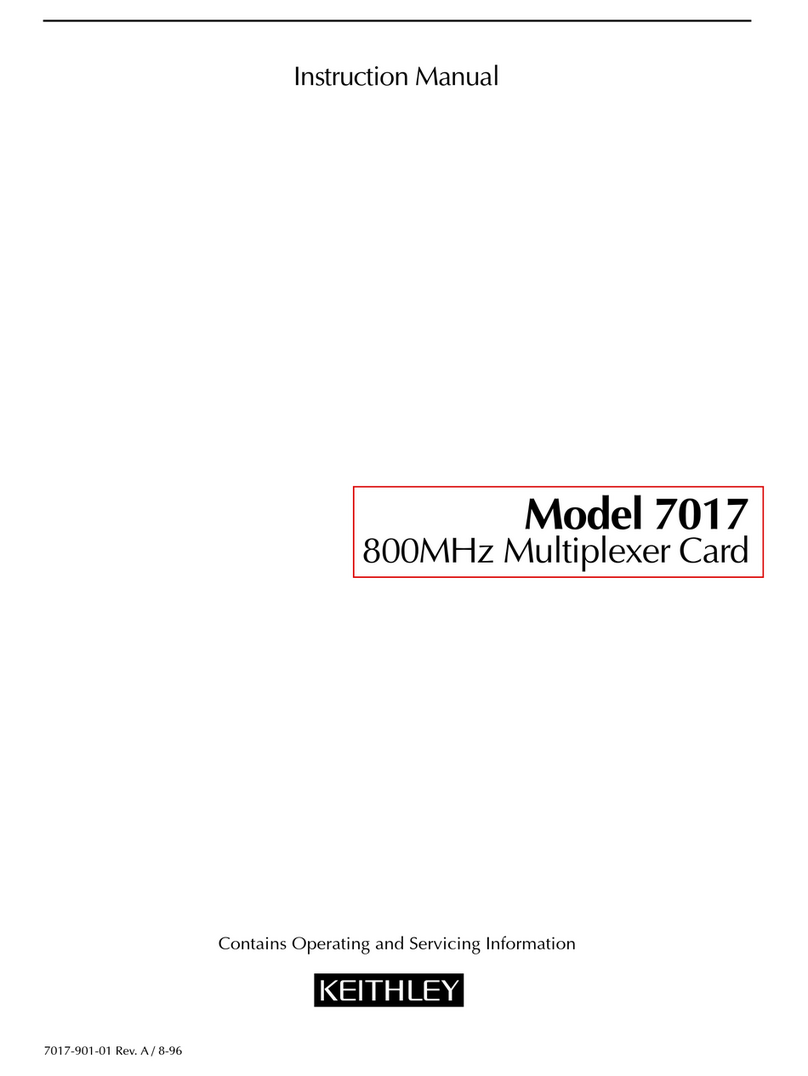
Keithley
Keithley 7017 User manual

Keithley
Keithley 7708 User manual

Keithley
Keithley 7702 User manual

Keithley
Keithley 7710 User manual

Keithley
Keithley 7706 User manual
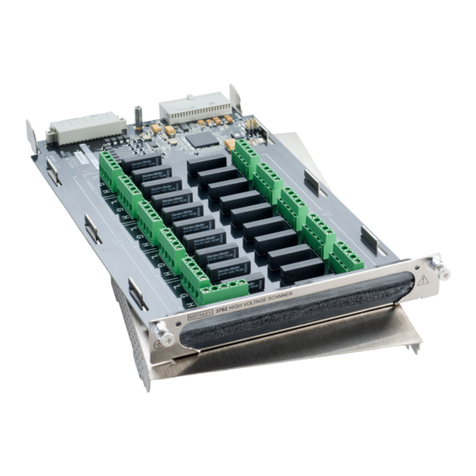
Keithley
Keithley 3706A User manual
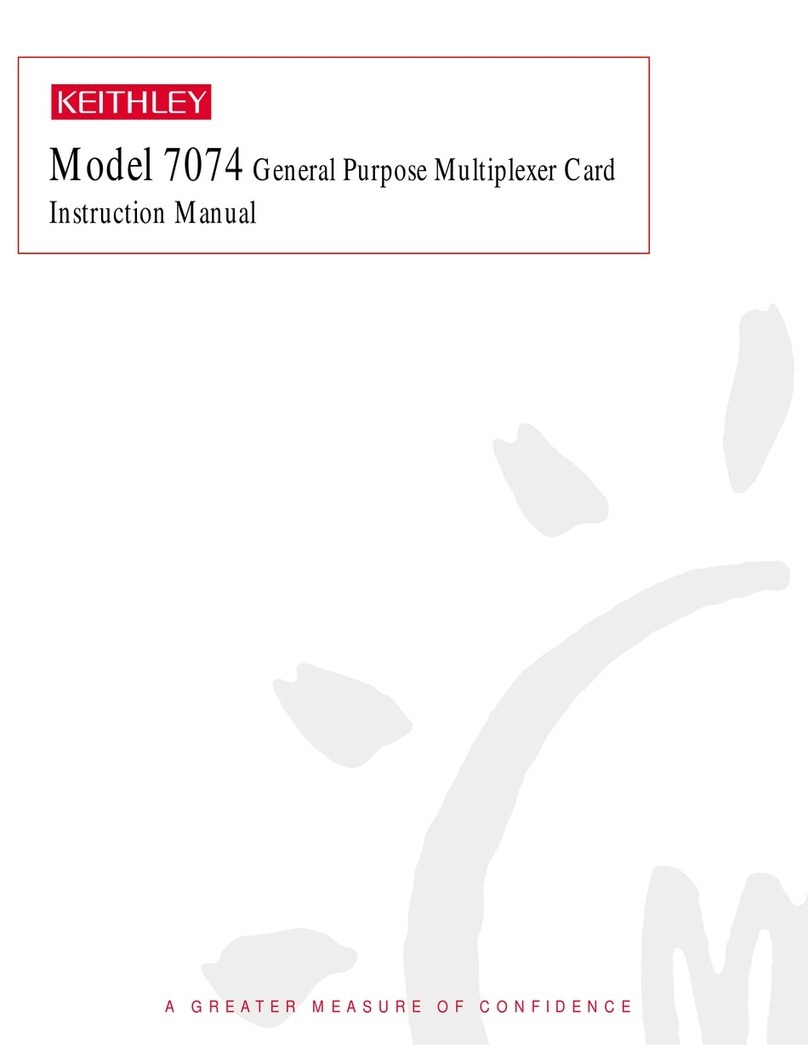
Keithley
Keithley 7074 User manual
Popular Multiplexer manuals by other brands
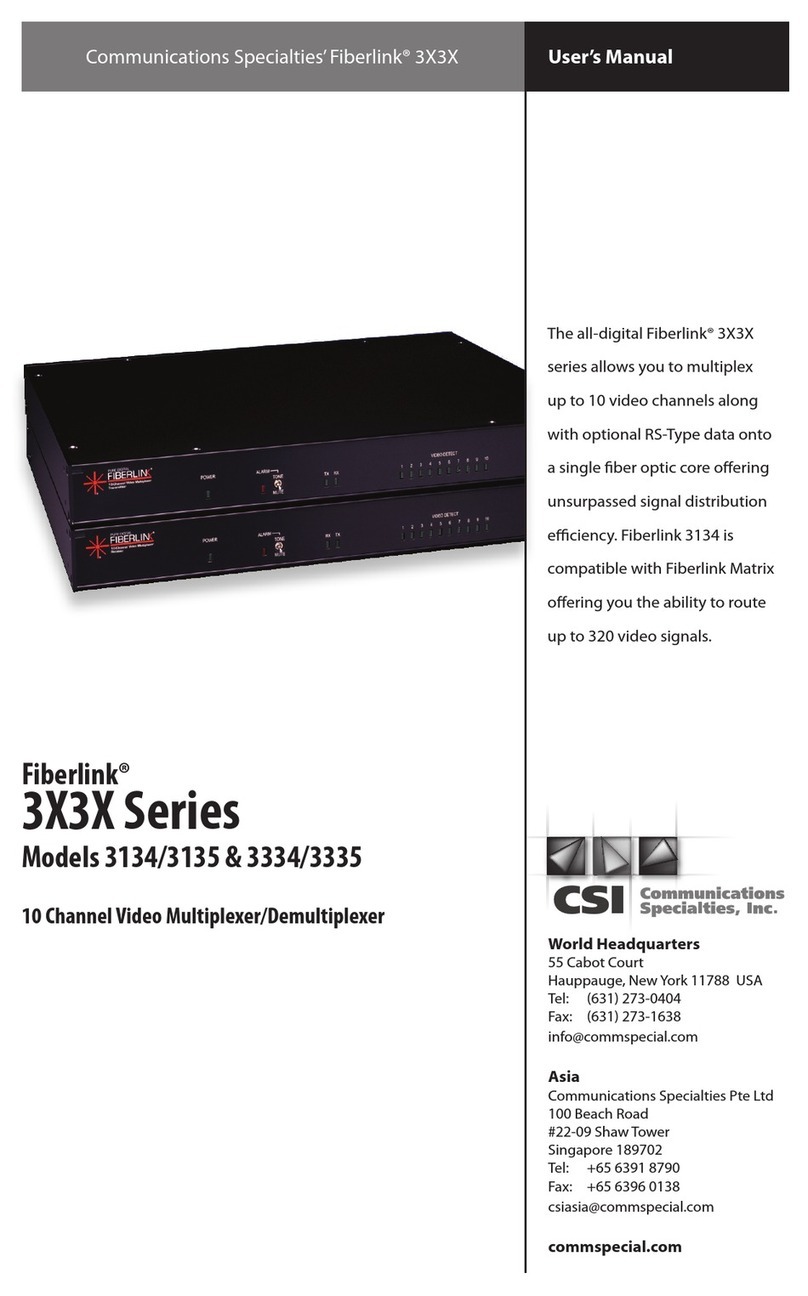
CSI
CSI Fiberlink 3 Series user manual
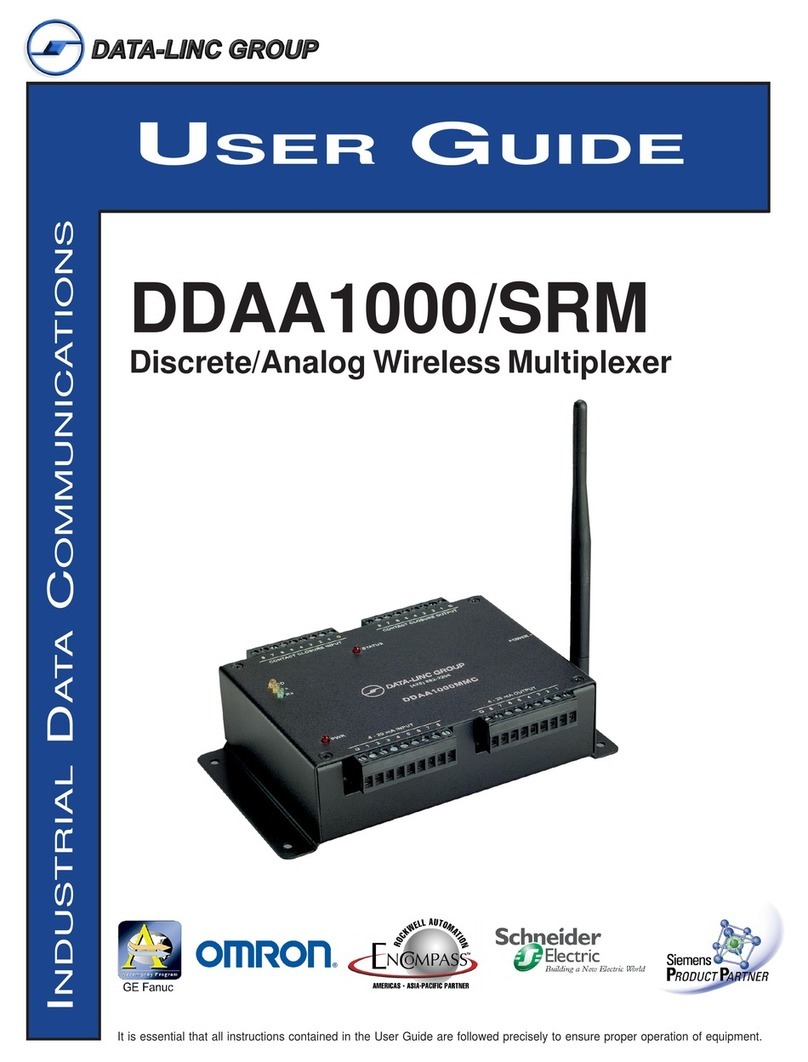
Data-Linc Group
Data-Linc Group DDAA1000/SRM user guide

Gree
Gree MULTI18HP230V1A Installation, service & troubleshooting
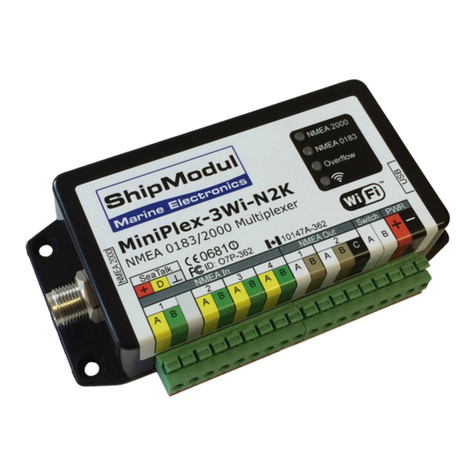
ShipModul
ShipModul MiniPlex-3 Series manual
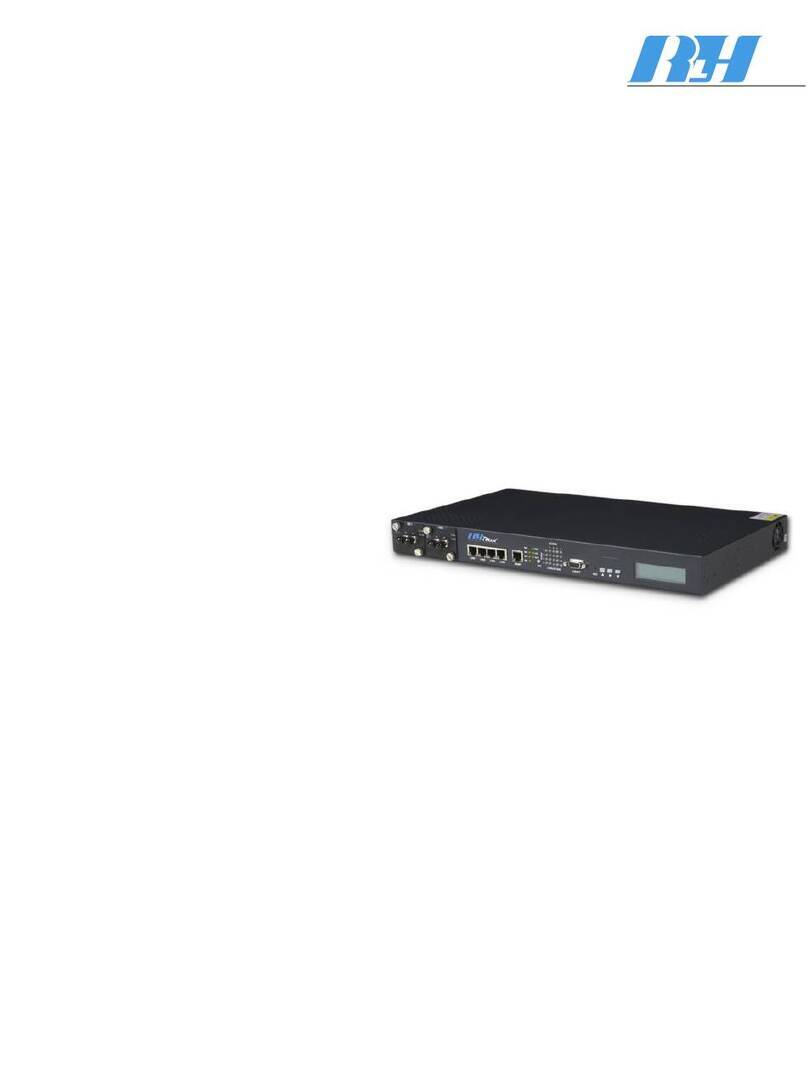
RLH Industries
RLH Industries iMux user guide

Lucent Technologies
Lucent Technologies Metropolis installation manual

